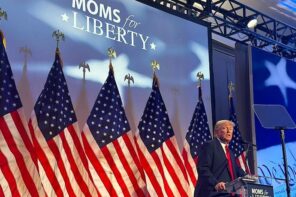The U.S. Census Bureau, never one to rush to judgment, has now made it official: fewer than 50% of the babies born in the United States during the year ending in July of last year were white.
That’s right: among the nursery set, certifiably white bundles of joy are now in the minority, and this trend is considered irreversible in view of the higher fertility rates among immigrant groups already living here and a virtual end to the in-migration of whites from abroad.
The New York Times reported this in Column One noting only that, in respect to potential future conflict, at some point active workers of color will at some point support, via their payroll taxes, Social Security payments that are made primarily to white retirees.
This observation implies that younger people of color might take counsel among themselves and decide that it’s not such a great idea to subsidize old white people. Myself, I think it’s much more likely that the old white people will use their undue political influence to squeeze more from those whom they were once pleased to refer to as “the minorities” (and other less polite terms).
I say this as a Californian, where non-Hispanic whites ceased to be the majority group in 1999 but where whites still very much rule the political roost in ways that have terrible consequences for younger Californians of color. Seeing the end in sight, conservative white Californians began more than three decades ago to implement a series of voter-enacted restrictions on the raising of any new taxes or fees.
Taken together, these restrictions created the ironclad supermajority requirements that now block the California legislature and all local elected bodies in this state from raising adequate revenue to support the education of kids who (surprise!) don’t look like “us” anymore. The effects of the revenue chokehold are plain to see: K-12 schools in California now rank at or near the bottom on various national scales, and California’s once-vaunted high-quality, low-cost public higher education system has been almost entirely trashed.

This chart (courtesy of Prof. Manuel Pastor, director of USC’s peerless Program for Environmental and Regional Equity) shows how non-Hispanic whites from throughout the entire United States will soon be following those from the Golden State into minority status; it may take another 30 years for the whole country to get there, but it’s coming.
In a sane culture—i.e., a culture in which social participation and social belonging had nothing to do with race or ethnic origin—the coming eclipse of white majority status wouldn’t mean a thing. It might even be celebrated, democratically, by whites themselves.
America’s most visionary spirits (e.g., Walt Whitman in “Democratic Vistas”) always expected the idea of American democracy and the idea of a new and blended population to lift people above any form of tribalism. Alas, this is not that kind of sane culture. Tribalism, especially white tribalism, still runs deep. And as religion has everything to do with this particular form of insanity, religion is where we should look, both to gauge the scope of the problem and to scan for possible pathways to sanity.
The Old Religion of Whiteness Persists in New Forms
The distinctly American hierarchical system, the comprehensive system of economic and social control that James Lawson tellingly refers to as “plantation capitalism,” has long been thoroughly bonded to a white supremacist ideology. Bad religion functions as the binding agent, sanctifying hierarchy and validating racial subordination. No one, then or now, seems to catch the irony of Christianity—a distinctly un-tribal religion in its origins—becoming a primary vector for raw white tribalism on American soil.
You don’t need the likes of me to walk you down these familiar byways, but just consider (if you please) the seamlessness lying within the old expression “white Christian nation.” When world-bestriding figures like Theodore Roosevelt spoke of “the nation” or “the national interest,” he did not need to spell out (although he often did) that he was referring to white Christian people, particularly white Christian men. Roosevelt’s view, completely consonant with the view of others of his era who had laced their Christian perspective with a dash of Darwinism, was that white people and people of color had simply evolved to different levels of civilization, with whites at the top and blacks at the bottom. Roosevelt considered himself enlightened and progressive and a “friend” to lesser peoples. In 1901 he even invited Booker T. Washington to dine at the White House (a political mistake he never repeated after the incident provoked a tremendous white backlash).
More than a century beyond Roosevelt’s day, one does not often hear the words “white Christian nation” uttered out loud any longer. What one does hear, however, amounts to code for the same thing. Thus, R.J. Rushdoony’s still-influential ideas about forging a godly nation—a nation organized according to biblical law—take it pretty much for granted that godly social organization has whites on top. Rushdoony, who lived into the current century, condemned interracial marriage as “unequal yoking.”
Un-dead David Barton, another hugely influential figure and hero to the religious right, doesn’t really need to say anything at all about retaining white hegemony, even if he hasn’t spoken at a white supremacist event in two decades. But it’s there by implication when Barton assaults church-state separation as a heathenish imposition upon the Founders’ original plan to build the new nation on Christian principles and to keep (white) Christians in charge.
Figures like Rushdoony and Barton may be dismissed as pseudo-intellectuals with crank followings, but I am quite sure that millions of white Americans who have never heard of these guys would still nod their heads in solemn agreement upon hearing the basic line: “God gave this fair continent to white people to occupy and populate. God has clearly blessed and prospered white people here. Others are certainly welcome to scoop up the crumbs from the table of American abundance, but no one who isn’t white should kid themselves about whose table it really is.”
To be clear, again: this openly racist view is no longer trumpeted in the public square in the plain light of day. So, for example, laws and practices known to subjugate and suppress the political voice of millions of African Americans via mass incarceration remain, on their surface, race-neutral. Legislators in Alabama and elsewhere who enact what amount to immigrant-exclusion acts, and legislators in many of these same states who craft laws aimed at voter suppression, will cite all kinds of reasons why they judge these measures to be necessary. But does anyone doubt that the threat to white hegemony (both economic and cultural) plays a major role in creating such legislative monuments?
Methinks the implied continuing linkage of “American” to “white Christian” also accounts for a good bit of the obsession with Obama as an outsider: neither a true American (where is that birth certificate?), nor a true Christian. If you doubt that whiteness counts for more than the doctrine part, consider this: white Protestants who were taught to believe that Mormonism is a dreadful false religion will nevertheless treat Willard Mitt Romney as an honorary Christian for purposes of giving Barack Hussein Obama the boot.
For White Religious Progressives, Learning Real Servant Leadership
It is, of course, unbecoming for people like me to to sit in judgment of the poor benighted white Christians who fall for subtle or not so subtle appeals to racial identity and racial solidarity. Sitting in judgment may be the classic posture of white liberals, but it’s hardly good enough when so much is at stake over the next 30 years of momentous demographic change. Singing our little paeans to diversity while remaining remarkably un-diverse in our own pods; wagging our fingers from our ivory towers in response to ugly attacks on immigrants communities; not nearly good enough.
It’s not quite true that white religious progressives have remained totally on the sidelines. For a brief time some white congregations lived out a radical welcome by joining the New Sanctuary Movement—sheltering individual immigrant families from deportation—but these gestures were so little reported and remained so incomprehensible to most on the outside that they barely made a dent in the wider public consciousness. In addition, New Sanctuary’s focus was mainly on hospitality for immigrants who are here without documents; it did little to help the vastly greater number of immigrant community members today who were born in this country but who are still often treated as though they are here illegally.
Here’s a proposition: if breaking the grip of plantation capitalism and its political enablers requires the empowerment of immigrant communities and communities of color, then white liberals who are serious about wanting a significant progressive shift in the way this country is governed must offer maximum strategic support for the organization and mobilization of non-white people and non-white movements.
There is no shortage of ways to channel such support: fight voter disenfranchisement moves, call out anti-tax conservatives on the racial/ethnic subtext of their anti-tax campaigns, attack America’s thoroughly racialized system of mass incarceration, support union representation drives that bring greater income and dignity to immigrant workers and all people of color, and take an active role in local and regional organizing to maintain adequate funding for schools and public colleges serving students of color and the children of immigrants.
The truth is that many white religious progressives understand, in a theoretical way, that these are our proper tasks. But we are more than a little ambivalent about taking a supporting role rather than directly orchestrating things or preaching from on high. We haven’t learned the discipline or the grace of ethically-based accompaniment. And at some level we are anxious about what might happen to cherished values like LGBT equality as the active electorate gains greater pigmentation. (I would say, as an aside, that anyone who remains aloof from the existential struggles faced by immigrant and non-immigrant communities of color really has no business lecturing the leaders of those communties on the finer points of social inclusion and social justice).
To my mind, there’s no shame in being ambivalent or anxious if one acknowledges it—and also acknowledges openly, and rejects openly, the shamefulness of still wishing to run the world and keep the course of events under one’s control. But it’s not easy for those accustomed to to step out of the saddle and agree to to take the role of foot soldier in a march toward the unknown. White skin privilege among educated elites is every bit as persistent as white tribalism among non-elites—and in some ways more destructive.
Ethical accompaniment is a learned discipline. But it occurs to me that it’s a discipline that at least some white progressives—including religious progressives—did manage to learn and put to honorable use during the anti-apartheid struggle in South Africa. Those of us who already are, or will soon be, members of the new white minority could do worse than to study and learn from that still-resonant experience.




